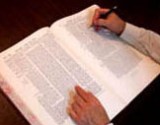 By Avi Zakutinsky
By Avi Zakutinsky
He laid his hands upon him and commanded him, in accordance with what G-d had spoken to Moshe. (Pinchas 27:23)
In this week’s parsha we are told of Moshe Rabbeinu giving semichah to his prized student, Yehoshua. Many people have a misunderstanding as to the true meaning of semichah and its hallachic ramifications. Semichah today has very few, if any, similarities to the act that Moshe performed. In this article we will describe the evolution of semichah in hallacha, and its significance today.
The Origins
Moshe Rabbeinu was the first ever to receive semichah. He received semichah directly from Hashem. Moshe in turn gave semichah to Yehoshua as was recorded in the verse cited above. In addition, he also performed semichah on the seventy elders. They in turn gave semichah to their students who gave semichah to their students etc. Thus the Rambam (Hilchos Sanhedrin chapter 4) notes that when one received semichah, even during the times of the Gemara, he entered an unbroken chain stemming back to Moshe Rabbeinu. This semichah allowed rabbanim to serve as judges on different batei denim dealing with capital or financial punishments. See the Rambam who enumerates the many hallachos of semichah, such as: We do not ordain rabbis outside of Israel, the semichah must be done by three Rabbanim and one of those rabbnim must have semichah himself etc.
When the Chain of Semichah Broke
It is very clear that at some point the chain of semichah broke. The question is when that occurred. Rav Chaim Palagi, in his Sefer Chukos Hachaim (page 109), proves that semichah continued at least until the times of Abaya and Rava. The Chasam Sofer (O.C. 203) writes that Hillel the Amorah (a contemporary of Abaya and Rava, not to be confused with the Tannaim Hillel and Shamai) and his chaveirim were the last to receive semichah. Rav Eliezer Yehuda Waldenberg zt”l, in the Sefer Hilchos Medina vol. 1 page 104, notes that the Ramban and the Tashbetz held the same sentiments centuries before the Chasam Sofer.
The Tashbetz (Zohar Rakia 54) describes the end of the era of semichah. He writes that hallacha dictates that in order for the Rabbanim to establish Rosh Chodesh they need to have been ordained. Hillel knew that the chain of semichah was not going to continue and he was concerned that we would be unable to establish the months and subsequently we would not have Yomim Tovim. He therefore instituted a calender which establishes the roshei chadashim automatically until the times of moshiach. It is clear from the words of the Tashbetz that semichah ceased around the time of Hillel.
Reinstituting Semichah
We have explained previously that in order to perform semichah on others the Rabbi must have been himself ordained. It would thus seem that once the chain of semichah broke we can not reinstitute semichah. This would indeed be the case if not for a very interesting ruling of the Rambam. The Rambam (Pirush Hamishna Sanhedrin first perek) writes that if all the chachamim of Eretz Yisroel are in agreement they are able to grant semichah. He notes that if we are unable to reinstitute semichah how else will we have a Sanhedrin during the times of moshiach, as we are unable to appoint a Sanhedrin unless the process of semichah exists. Rather, it must be true that if all the Rabbanim of Eretz Yisroel are in agreement they are capable of granting semichah, which will lead to the rebuilding of the Sanhedrin.
The Rambam in Yad Hachazaka (Hilchos Sanhedrin 4:11) codifies this ruling, however, he seems reluctant to rule this way for normative hallacha. He writes the following: “It appears to me that if all of the wise men in Eretz Yisrael agree to appoint judges and convey semichah upon them, the semichah is binding and these judges may adjudicate cases involving financial penalties and convey semichah upon others. If so, why did the Sages suffer anguish over the institution of semichah, trying to insure that the judgment of cases involving financial penalties would not be nullified among the Jewish people (as it would be when the institution of semichah ceased), because the Jewish people were dispersed, and it is impossible that all could agree (to reinstitute semichah). If, by contrast, there was a person who had received semichah from a person who had received semichah, he does not require the consent of all others. Instead, he may adjudicate cases involving financial penalties for everyone, for he received semichah from a court. The question requires resolution.”
Most meforshim explain that when the Rambam writes that this “question requires resolution” he is addressing the possibility of reinstituting semichah and he has reservations as to whether this is indeed the hallacha. It should be noted that the Bais Yosef (C.M. 295) proves that the Rosh is in agreement with the ruling of the Rambam.
The simple explanation of the Rambam is as follows. He feels that klal yisroel as a whole have the strength and ability to appoint judges for a Sanhedrin and since the rabbanim represent the people, they in turn are capable of reinstituting semichah. Rav Elchonon Wasserman zt”l (Kovetz Shiurim vol. 2 Divrei Sophrim 2:8) wonders why is it that only the rabbanim of Eretz Yisroel are significant when it comes to appointing members for the Sanhedrin, while the rabbanim of the diaspora are not part of the equation.
The answer to that question, perhaps, can be found in the writings of the Rambam in Hilchos Kiddush Hachodesh (5:13), who emphasizes that the determination of the calendar is solely the province of the inhabitants of Eretz Yisrael. And as the Chasam Sofer (Y.D. 234) notes were there not to be any Jews living in Eretz Yisrael, heaven forbid, we would not be able to determine the calendar. Thus the Rambam is telling us that when determining mitzvos, only the Jewish nation living in Israel has the significance of Klal Yisroel. Similarly in our discussion only the Rabbis of eretz yisroel are capable of appointing members for a Sanhedrin.
The Semichah of Rav Yaakov Bei Rav
In the year 1538, the Rabbanim of Tzfat (which was the majority of the rabbanim living within Eretz Yisroel at the time) came together and wished to reinstitute semichah based upon the opinion of the Rambam. They decided to ordain the Great Rav Yaakov Bei Rav. In addition, great sages like Rav Yosef Karo, the Mabit and the Alshich Hakadosh were ordained as well. They felt that the majority of the Rabbanim would suffice in order to reestablish the Sanhedrin.
However, the Rabbanim of Yerushalayim objected to this new semichah, most notably among them was the Maharlbach, who wrote a kuntres specifically to disprove of their actions. The Maharlbach and the Radvaz (on Rambam Hilchos Sanhedrin 4:11) noted some of the objections, I will list them here: 1) As noted above, it seems as though the Rambam was reluctant to rule definitively in this manner and therefore it is difficult to rely upon this ruling for normative hallacha. 2) The Rambam would require the consencs of all of the rabbanim of Eretz Yisroel. Although Tzfat contained the majority of the sages of Israel until all the rabbanim of Israel are in agreement we are unable to reestablish the Sanhedrin. Rav Yhonasan Eibshitz zt”l (Tumim 1:2) agrees that according to the Rambam one needs the concensus of all of the rabbanim, majority would not suffice. It seems as though the Meiri (Sanhedrin 14a) is in agreement, he writes that semichah can be conveyed if all of the rabbanim are in agreement. 3) Even if we assume that majority of rabbanim suffice, however, the minority still needs to take part in the deliberation, which did not occur. 4) To be worthy of sitting on the Sanhedrin one must be able to issue hallachic rulings on every category of Jewish law. The Maharlbach and the Radvaz had reservations whether sages of this caliber existed at the time. 5) And lastly, the Rambam was forced to issue this novel ruling because he had no other explanation as to how we will have a Sanhedrin during the times of Moshiach. The Radvaz offers the possibility that Eliyahu Hanvi will establish the Sanhedrin during those times. With that being said it is unnecessary to assume that we are indeed capable to reestablish semichah.
Rav Yechiel Tukazinsky zt”l (Ir Hakodesh V’Hamikdash vol. 4 chapter 16) writes that the semichah continued for almost one hundred years. The reason why it ceased was not due to the disagreement with the Maharlbach, as many mistakingly assumed, rather it was due to harsh living conditions in Eretz Yisroel. The Arabs were forcing many Jews to pay unjust fines and this forced many of the great rabbanim, who had received semichah, to move to the Diaspora.
Semichah Today
Although the chain of Semichah was severed, the prevalent custom amongst most of klal yisroel was to grant some form of “semichah” to young men. This “semichah” was a requirement to allow those young men to serve as rabbanim or dayanim. The Tzitz Eliezer cites sources to prove that the sefardic communities never accepted this as a custom.
Semichah during the times of chazal allowed for men to serve on a bais din dealing with capital or financial punishments. The questions that needs to be answered is; what is the nature of this new “semichah”, which of course cannot allow the recipient to dole out capital punishment, and are there circumstances which one can serve as a rav without it?
The Rivash (cited by Rama Y.D. 242:14) addresses this question and he writes that the new “semichah” is a form of permission to issue rulings in the vicinity of his Rebbi. As we know one is not allowed to issue hallachic rulings in the vicinity of one’s rebbi unless the Rebbi grants permission to do so. This semichah is formally granting the student permission to issue hallachic rulings. Therefore, notes the Rama, if the Rebbi has passed on it is unnecessary for the student to receive semichah.
That being said, it is important to note that historically there were many fake “rabbis” who were not learned and unfortunately took advantage of many simple Jews. These “rabbis” would give their “hechsher” to non-kosher establishments for the right price (see letters of the Ridvaz in the hakdama to his sefer). Therefore semichah was extremely necessary to help discern between the real rabbis and those who were fake. This was the main reason that one could serve as a Rav without this letter of recommendation.
{Matzav.com Newscenter}











